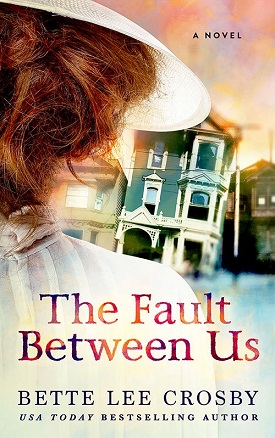 Synopsis:
Synopsis:
What were the odds that a girl born and raised in Philadelphia would encounter a stranger from California on the trolley and fall madly in love with him? But that’s what happened. Templeton was not only taken with John Morehouse, but also with his tales of life in San Francisco. As an aspiring fashion designer, the dazzle of a city called the Paris of the West with its towering department stores and European couture was too much to resist.
Despite her family’s objections, she and John are married and on their way back to California before the month is out. To ease her family’s heartbreak and consternation, Templeton promises they will return for a visit every summer. And she intends to keep that promise, but as her fashions gain popularity, the business grows increasingly more demanding. The trips back to Philadelphia become less frequent and she makes foolish choices she will soon regret.
On April 18, 1906, just as she is on the verge of having everything she’s ever wanted, a devastating earthquake tears San Francisco apart. Templeton awakes on that fateful morning to find that the father of her baby is missing, the city in flames.
Templeton’s father leaves Philadelphia and sets out in search of his son-in-law. But he’s too old for such a grueling trip and ill-equipped for the challenges he will encounter. But he’s the only hope of saving his daughter’s happiness. Lines of communication are down and the city is in shambles. The only thing Templeton can do is pray she doesn’t lose both her husband and her father.
Review:

The Fault Between Us finds Templeton Whittier, the daughter of prominent Philadelphia attorney Albert and his wife, Eleanor, turning down would-be suitors and focused on her fashion business. She defiantly declared she had “no interest in marrying. Not now and perhaps not ever. This is 1895! There’s nothing to stop a woman from having a career if she’s a mind to do so.” She predicted her designs would soon be featured in the front window of Wanamaker’s, the store that helped shape the retail industry, and accomplished her goal when the women’s wear buyer ordered sixteen of her designs.
But everything changes in April 1903 when Templeton meets John Morehouse. He strikes up a conversation with her on the streetcar and Templeton is immediately smitten. He describes what life is like in the beautiful city of San Francisco where she’s certain stores like the Emporium and City of Paris would buy her designs. Templeton has never seen the world that exists beyond Philadelphia County and is transfixed by John’s depiction of “the Paris of the West” . . . and John himself. They spend every moment together during the next two weeks, but his introduction to her family does not go well, particularly when her parents learn where he lives, a detail that Templeton purposely failed to mention to them. Her mother is scandalized when she learns that they met on a streetcar, and absolutely horrified when Templeton and John plan to marry quickly so that Templeton can return to San Francisco with him as his wife.
If you ever wonder what’s the most important thing in your life, measure the love of family against anything else, then ask yourself which of those you can’t live without. I assure you it won’t be the shiny bright toy that’s caught your eye. ~~ Templeton in The Fault Between Us
The decision to marry John is not one that Templeton makes lightly. She knows that she will miss her parents, older brother and sister, and their families tremendously, as well as her friends. She will also have to re-launch her business in San Francisco, a city in which she knows no one and has no connections. No one is more surprised than she is at the depth of her feelings for John and her desire to spend her life with him. She understands and appreciates the way her parents view her conundrum. San Francisco is a four-day train trip away and her father expresses concern that John may not be entirely truthful about his life and business. They have never approved of her career ambitions and would prefer that she remain near the family, focused on raising children. “Marrying a man you’ve known for less than two weeks is pure foolishness. Give it time, wait and see if you both feel the same six months or a year from now,” Albert fumes. But Templeton recognizes that “love never takes sensibility into account. Your heart doesn’t stop and ask questions . . . It hits, and just like that your world is changed . . . and that’s when you know this is your forever.”
Crosby believably depicts Templeton’s journey to and new life in San Francisco, a city she quickly discovers is very different from Philadelphia. The tastes and desires of the society women to whom she hopes to market her fashions are not the same as those of Easterners and her career ambitions threaten her initially idyllic relationship with John, who wants to start a family quickly. Atypically supportive of Templeton’s desire to succeed in business, John lends assistance, but she tests his limits. He insists that she be a wife and mother first, and designer second. “I’ve always appreciated the fact that you have a talent and want to have a business of your own, but now it’s almost an obsession. It’s all you talk about, all you think about,” John accuses, feeling ignored. In order to achieve all of her personal and professional goals, Templeton selfishly harbors secrets that threaten to destroy the life she and John are building, and derail their future.
Crosby employs a third-person narrative to relate the story, but effectively inserts first-person interludes between chapters in which the characters share their innermost thoughts and feelings. In one such passage, Templeton plausibly laments, “I would bet my last dime no one ever told a man that he shouldn’t have a job simply because he’s married.” She bemoans the fact that she gave up her home and business in Philadelphia to marry him, while John has given up nothing, but insists that she has no regrets. Still, to pacify her husband, she resolves to downplay her devotion to her business and diminish its visibility to him. Contributing to her misery is the fact that she misses her family desperately. Nonetheless, she becomes so consumed by her burgeoning business that she breaks her promise to return to Philadelphia every year for a lengthy visit. Intuiting that her family’s lives are progressing happily without her only intensifies her discontent.
Crosby has penned a classic story of a woman striving to “have it all” set in the early twentieth century, a time period in which Templeton is really a woman ahead of her time. “The world simply was not ready for working women; someday, perhaps, but not now.” Her struggle to balance her career ambitions against her deep love for her husband and desire to start a family is portrayed in a relatable manner.
Templeton and the marriage survive the challenges that beset her early years in San Francisco. She and John finally return to Philadelphia for a visit, with Templeton confident that she won’t make the same mistakes again and looking forward to the future. She stays behind when John returns to San Francisco, eager to re-join him in a few weeks when she will happily inform him that he is finally going to be a father.
At that point, the story’s tone intensifies as Crosby takes readers on a harrowing journey with her characters. On April 18, 1906, John is at home asleep when the 7.9 earthquake strikes at 5:12 a.m. He awakes with “an agonizing scream” when the house shudders, shakes, and sustains major damage. As word of the initial earthquake, and the devastating aftershocks and fires, reaches Philadelphia, John’s fate is unknown. Templeton and her family anxiously hope for a telegram from John assuring them that he is safe. In a world before mass media and instantaneous news updates, the days pass agonizingly slowly until Albert decides that he must go to San Francisco to search for John because if he doesn’t, Templeton will defy reason and do so herself. Albert reluctantly admits that Templeton is his favorite child because she is so much like him — “Full of sass and vinegar, fiery . . . ” — and is willing to risk everything to see that she and her unborn child are safe. Templeton and Eleanor remain at home as Albert embarks on the long trip by train, headed to Oakland where many survivors are being treated for their injuries or residing in hastily established refugee camps. From there, Albert takes the ferry to San Francisco and is horrified by what he finds. Trudging miles on foot, Albert encounters dangers he did not anticipate and a kind stranger along the way. Crosby’s depiction of the once-stately city’s destruction is heartbreakingly accurate, as is her portrayal of the consternation Templeton and Eleanor endure for days on end as they await word of their husbands’ fates.
The Fault Between Us is an entertaining tale about a young woman named for her father’s great-uncle because, like him, she is intelligent and inquisitive, but also headstrong and determined, qualities that bring her both great joy and significant heartache. In a time when women are expected to conform to societal norms by devoting their lives to marriage and motherhood, Templeton is bent on defying expectations by establishing both a thriving family and successful business. Crosby’s compassionate and illustrative storytelling endears readers to her characters and she vibrantly conveys their emotional struggles, most particularly those of Templeton and her beloved, often bewildered father who is very much a man of his time.
The book’s themes are conveyed through its clever title. In The Fault Between Us, Templeton and John’s marriage is threatened by metaphorical faults, as well as the terror wrought by California’s infamous San Andreas fault system. Historical fiction fans will enjoy learning if their relationship endures, as well as what wisdom Templeton gains as a result of her experiences.



Comments are closed.